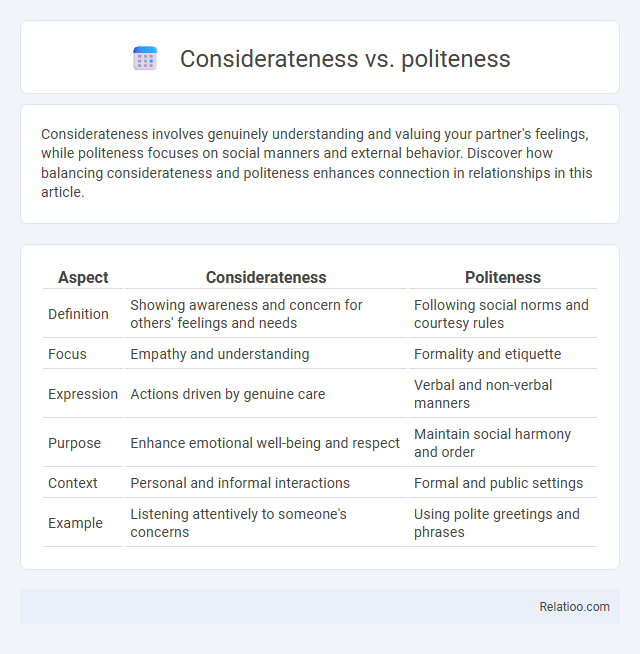Considerateness involves genuinely understanding and valuing your partner's feelings, while politeness focuses on social manners and external behavior. Discover how balancing considerateness and politeness enhances connection in relationships in this article.
Table of Comparison
| Aspect | Considerateness | Politeness |
|---|---|---|
| Definition | Showing awareness and concern for others' feelings and needs | Following social norms and courtesy rules |
| Focus | Empathy and understanding | Formality and etiquette |
| Expression | Actions driven by genuine care | Verbal and non-verbal manners |
| Purpose | Enhance emotional well-being and respect | Maintain social harmony and order |
| Context | Personal and informal interactions | Formal and public settings |
| Example | Listening attentively to someone's concerns | Using polite greetings and phrases |
Introduction: Defining Considerateness and Politeness
Considerateness involves a deep awareness of others' feelings and needs, driving actions that prioritize empathy and kindness. Politeness, by contrast, centers on socially accepted behaviors and language that maintain harmony and respect in interactions. Your ability to balance considerateness and politeness enhances communication by fostering genuine respect while adhering to social norms.
Core Differences Between Considerateness and Politeness
Considerateness involves genuine care for others' feelings and needs, reflecting empathy and understanding, while politeness is more about following social norms and etiquette to show respect and maintain harmony. Considerateness often leads to personalized, thoughtful actions, whereas politeness tends to be more formal and structured, adhering to expected behaviors in specific contexts. The core difference lies in considerateness being internally motivated by compassion, whereas politeness is externally motivated by social conventions.
Historical Perspectives on Social Etiquette
Historical perspectives on social etiquette reveal nuanced distinctions between considerateness and politeness, where considerateness emphasizes genuine empathy and attentive concern for others' well-being, while politeness often adheres to formal social codes and rituals established by cultural norms. In Victorian England, for instance, politeness was codified through strict manners and etiquette manuals, reflecting societal hierarchy and decorum, whereas considerateness was more about sincere interpersonal sensitivity beyond mere appearances. Over time, these concepts evolved with shifting social values, highlighting how cultural context shapes the balance between outward politeness and inward considerateness in social interactions.
The Role of Empathy in Considerateness
Empathy plays a crucial role in considerateness by enabling individuals to genuinely understand and respond to the feelings and needs of others, beyond the superficial gestures of politeness. Considerateness involves a deeper emotional connection that fosters respect and support through thoughtful actions, while politeness often centers on social norms and etiquette. This empathetic awareness allows for more meaningful interpersonal interactions and promotes a compassionate environment.
Social Expectations and Politeness Norms
Social expectations shape how Considerateness and Politeness guide interactions, with Politeness emphasizing adherence to cultural norms and rituals. Considerateness focuses on empathy and attentiveness to others' feelings, often transcending rigid societal rules. Your ability to balance these elements influences social harmony and the effectiveness of communication within various cultural contexts.
Practical Examples: Considerateness vs Politeness in Daily Life
Considerateness involves being mindful of others' feelings and needs, such as offering help when someone struggles with heavy bags, while politeness focuses on following social norms, like saying "please" and "thank you." Your ability to balance both can improve daily interactions, for example, holding the door open demonstrates politeness, but noticing when a colleague needs a moment of quiet to concentrate shows considerateness. These subtle differences enhance workplace harmony and personal relationships by blending respect with empathy.
Impact on Relationships and Communication
Considerateness involves understanding and respecting others' feelings, directly enhancing empathy and trust in relationships. Politeness follows social norms and etiquette, facilitating smoother communication but may lack genuine emotional connection. Your ability to balance considerateness with politeness strengthens meaningful interactions and fosters deeper, more effective communication.
Cultural Interpretations of Considerateness and Politeness
Cultural interpretations of considerateness and politeness vary significantly, influencing social behavior and communication norms worldwide. In East Asian cultures, politeness often involves indirect speech and honorifics to maintain group harmony, whereas Western cultures may emphasize directness combined with courteous language. Considerateness extends beyond verbal politeness to actions reflecting empathy and respect, shaped by cultural values such as collectivism or individualism.
Challenges in Balancing Considerateness and Politeness
Balancing considerateness and politeness often presents challenges because while considerateness requires genuine empathy and understanding of another's feelings, politeness primarily follows social norms and etiquette. Your challenge lies in expressing true care without compromising social expectations or appearing insincere. Achieving this balance demands careful attention to context, tone, and the individual needs of those you interact with.
Conclusion: Fostering Meaningful Interactions
Fostering meaningful interactions requires balancing considerateness, which involves empathy and genuine concern, with politeness, characterized by socially accepted behaviors and manners. By prioritizing authentic understanding over mere formalities, relationships deepen through mutual respect and emotional connection. This synergy enhances communication, creating an environment where trust and cooperation thrive.

Infographic: Considerateness vs Politeness
 relatioo.com
relatioo.com